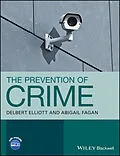The Prevention of Crime provides a unique and comprehensive overview of effective crime prevention programs, strategies and policies, demonstrating how criminological theories, research, and practice are interrelated.
* Offers the most cutting-edge, comprehensive summaries of effective interventions based on the latest research, by the foremost scholars on the topic of crime prevention in the U.S.
* Provides unique practical information and discussions on how to effectively replicate prevention strategies in communities and criminal-justice settings is highly relevant to students, providing them with the latest research in this area
* Coverage of multiple theories of crime includes the more recent public-health and life-course developmental perspectives
* Includes a comprehensive review of the increasing number of effective crime prevention interventions and the practicalities of ensuring that these programs, practices and policies are effectively implemented, both in the U.S and in other countries
* Presents the most cutting-edge current and optimistic view regarding crime prevention: that it is possible to effectively reduce crime but that efforts need to start early in communities and continue through the life-course
Autorentext
Del Elliott is a Distinguished Professor in the Institute of Behavioral Science at the University of Colorado Boulder. He is the Founding Director of the Blueprints for Healthy Youth Development initiative, an online registry of effective prevention programs and was the Science Editor for Youth Violence: A Report of the Surgeon General (2001). Dr. Elliott's most recent books include Multiple Problem Youth: Delinquency, Drugs and Mental Health Problems (1989), Violence in American Schools (1998) and Good Kids from Bad Neighborhoods (2006). He is a Past-President and Fellow of the American Society of Criminology and a recipient of the Edwin H. Sutherland and August Vollmer Awards from the Society.
Abigail A. Fagan is Associate Professor in the Department of Sociology, Criminology & Law at the University of Florida. Dr. Fagan's research investigates the causes and prevention of juvenile delinquency, including how to increase the use of evidence-based programs, policies, and practices to reduce crime. Her research has been funded by the National Institute on Drug Abuse and the National Institute of Justice and published in leading journals in criminology, psychology, and public health.
Klappentext
"This is the most complete description of the history, theories, strategies, methods, evaluations and outcomes of efforts to prevent crime ever written. Encyclopedic in scope, it is exceptionally well organized and clearly presented. It is essential reading for students, professionals, policy makers, and citizens seeking to understand how criminal behavior can be prevented. It is equally instructive regarding what has not worked to prevent crime. There is simply nothing like it. Truly a remarkable achievement."
J. David Hawkins, University of Washington
Criminology and criminal justice currently place great emphasis on the need to implement evidence-based crime prevention strategies. The Prevention of Crime is the first text to draw from multiple, emerging, cutting-edge frameworks to demonstrate how this can be done. It describes many effective models of prevention programs and strategies that have been developed and are available for use both in the US and abroad. The text includes attention to situational crime prevention, developmental prevention programs and correctional practices to provide a unique, integrated and holistic review of what works.
In contrast to most crime prevention books, The Prevention of Crime includes attention to the many challenges associated with the implementation of crime prevention strategies, along with practical guidance regarding how communities can best select and implement such efforts, both nationally and internationally. The text also describes popular prevention models that are widely used, yet which have been shown to be largely ineffective in reducing crime, thus helping to dispel the many myths that persist in the field.
Zusammenfassung
The Prevention of Crime provides a unique and comprehensive overview of effective crime prevention programs, strategies and policies, demonstrating how criminological theories, research, and practice are interrelated.
- Offers the most cutting-edge, comprehensive summaries of effective interventions based on the latest research, by the foremost scholars on the topic of crime prevention in the U.S.
- Provides unique practical information and discussions on how to effectively replicate prevention strategies in communities and criminal-justice settings is highly relevant to students, providing them with the latest research in this area
- Coverage of multiple theories of crime includes the more recent public-health and life-course developmental perspectives
- Includes a comprehensive review of the increasing number of effective crime prevention interventions and the practicalities of ensuring that these programs, practices and policies are effectively implemented, both in the U.S and in other countries
- Presents the most cutting-edge current and optimistic view regarding crime prevention: that it is possible to effectively reduce crime but that efforts need to start early in communities and continue through the life-course
Inhalt
Preface vii
Acknowledgments ix
About the Companion Website x
Section I Introduction to Crime Prevention 1
1 The Goals and Logic of Crime Prevention 3
2 A Brief History of Crime Prevention 31
Section II The Foundations of Crime Prevention 67
3 How Theory and Research Inform the Science and Practice of Crime Prevention 69
4 Evaluation Science 105
5 Establishing a Standard for Judging Intervention Effectiveness 139
Section III What Works to Prevent Crime? 165
6 Situational and Legal Crime Prevention Practices, Programs, and Policies 167
7 Contextual Interventions 199
8 Individual?]Level Crime Prevention: Preventing the Onset of Crime 244
9 Individual?]Level Crime Prevention: Reducing the Continuity of Offending 274
Section IV Crime Prevention in Practice 299
10 Selecting and Implementing Effective Crime Prevention Practices, Programs, and Policies 301
11 Implementation Science: Taking Effective Crime Prevention Programs, Practices, and Policies to Scale 328
12 The Future of Crime Prevention 360
Glossary 379
Author Index 388
Subject Index 400
